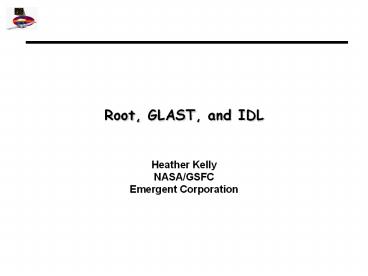Root, GLAST, and IDL - PowerPoint PPT Presentation
1 / 11
Title:
Root, GLAST, and IDL
Description:
Joint NASA/DOE project, with numerous collaborators from many countries. ... Interative Data Language. A commercial product available from Research Systems Inc. ... – PowerPoint PPT presentation
Number of Views:21
Avg rating:3.0/5.0
Title: Root, GLAST, and IDL
1
Root, GLAST, and IDL
- Heather Kelly NASA/GSFCEmergent Corporation
2
Gamma-ray Large Area Space Telescope
- Joint NASA/DOE project, with numerous
collaborators from many countries. - Pair Conversion Telescope designed to detect
photons in the energy range of 10 keV 300 GeV. - Scheduled for launch March, 2006.
- Modular 4x4 design of identical towers. Each
tower consists of a Tracker and CsI Calorimeter.
The 4x4 array is covered by an Anti-Coincidence
Shield to reject charged cosmic rays.
3
GLASTs Use of Root
- First use of Root 1999 SLAC beamtest.
- For both data storage and analysis
- Created our first Root classes to store raw
detector data. - Mid-2000 created Root classes to store our
reconstructed data. - Since then, we have migrated our simulation and
reconstruction algorithms to the Gaudi framework.
- Currently preparing for a balloon flight this
summer. - Now we will store HSK data in Root as well.
- Also gearing up for bulk Monte Carlo production.
- Plan to store MC data in Root.
- We are now prepared to handle Root I/O to store
output data and to re-ingest that data for
re-processing.
4
From Space/Simulation to Root
MC Generator
Gaudi Framework
MC Digitization Algorithms
Raw Telemetry
MC Hits
raw data
Reconstruction Algorithms
Instrument Op Center
reconstructiondata
TransientDataStore
Level 0 data
User Analysis Algorithms
Root I/O
Housekeeping Branch
Raw Branch
MC Branch
Recon Branch
TNtuple Branch
Root Analysis
IDL
5
Interative Data Language
- A commercial product available from Research
Systems Inc. - It is an analysis tool kit, familiar to many
astrophysicists and earth scientists. - Very polished professional software, supported on
a variety of platforms Unix, Windows, VMS. - Strong visualization tools.
- Accepts data in a variety of formats including
FITs and HDF. - Drawbacks Expensive, commercial software
- There are some GLAST collaborators who are
faithful IDL users!
6
How will GLAST support IDL users?
- Do nothing.
- We have limited resources, we could choose to
just support Root as our analysis toolkit and
provide C code to access the data. - Convert Root data into some other format that IDL
will ingest. - Do we want 2 persistent copies of the same data?
- Provide a mechanism for IDL users to access Root
files directly from within IDL. - Root is an I/O library and an analysis toolkit.
- Allow users to choose what analysis toolkit they
wish to use. - Good for the users and good for Root.
- In the endit is about accessing the data.
- Many users have extensive libraries of IDL
routines. - Some are not interested in learning C.
- Others are very excited to use Root as an
analysis toolkit. - We provide data access and a set of common
routines written in C that will be accessible
to both Root and IDL users.
7
Root2IDL Proof of Concept
- For our 1999 beamtest stored our data in Root
trees. - IDL is written in ANSI C on all platforms.
- IDL provides a mechanism to call external
routines through Dynamic Load Modules (shareable
library). - A DLM provides a common interface to IDL, that
allows IDL to call the routines within a
user-defined shared library. - The fact that the routine is external is
transparent to the user. - Behaves as an IDL system routine.
- For the beamtest, a DLM, Root2IDL, was created to
handle the specific TTree structure we were
using. - The DLM reads in the Root tree data and converts
it into an IDL structure (equivalent to a C
structure). - The data is then available within IDL.
8
Example Interface to IDL
include "export.h // Include file available
with IDL distribution static IDL_VPTR testfun(int
argc, IDL_VPTR argv) return
IDL_StrToSTRING("TESTFUN") int
IDL_Load(void) static IDL_SYSFUN_DEF2
function_addr testfun,
"TESTFUN", 0, IDL_MAXPARAMS, 0, 0,
/ Register our routine./ return
IDL_SysRtnAdd(function_addr, TRUE,
ARRLEN(function_addr))
9
Root2IDL in Action
10
Problems / To Do List
- IDLs DLM interface has migrated in versions
5.25.4. - Need a generic interface for all Root files.
- Our Root classes will certainly evolve plus a
general utility may be useful to the community at
large. - This is possible due to TStreamerInfo!
- Optimization is necessary.
- Plan
- Upgrade the Root2IDL DLM to handle our specific
Root class structure for our upcoming balloon
flight and MC simulations. - Once things settle down, we can then proceed to
provide a generic utility for any Root file.
11
Suggestions for Root
- Windows support
- Many GLAST collaborators are Windows users and
will perform some analysis using Root
interactively on Windows. There are quirks in
the GUI. - Root and Gaudi
- Projects also using Gaudi as their framework
would love to see a persistency mechanism that
handles real Root. - It is difficult to keep up with the upgrades in
Root from version to version. We may not always
be able to upgrade in a timely manner. - Some Great New Things about Root
- Dedicated users
- Tree Friendship
- Apache server































